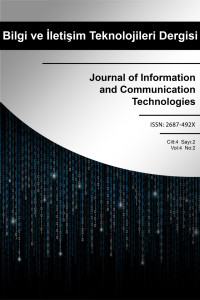Öz
The billions of new media platforms available online allow people to represent themselves and meet like-minded people. Thus, a human-based, lively and dynamic public opinion is formed in cyberspace as well. A free and egalitarian representation should be given to all groups in order to ensure the democracy of cyberspace. The states and users who carry the current power struggles to the cyber space restrict cyber democracy. In this study, which is handled within the framework of new media and cyber activism, the motivation of hacktivism, which is a marginal and aggressive type of cyber activism, is accepted as proving its existence and power in the cyber field. DDOS (Distributed Denial of Service)attacks are one of the most preferred attack types by hackers, who are the representatives of the struggle for power and public administration in cyberspace. The aim of the study is to help determine the criteria to distinguish cyber activism from other cybercrimes. The criteria used in DDOS taxonomies are presented in the literature. In order to distinguish cyber activism from other cybercrimes, cyber attacks affecting the public in Turkey were examined and a table containing the messages of hackers and findings were presented. As the result, it has been proposed to include the determining criteria in DDOS taxonomies by making hacktivism motivations visible.
Anahtar Kelimeler
cyber activism ddos attacks new media cyber threath taxonomy public sphere
Kaynakça
- Brenner, S. W. (2010). Cybercrime: Criminal Threats from Cyberspace. Santa Barbara, California: Praeger. Castells, M. (2008). Bin Yılın Sonu: Enformasyon Çağı, Ekonomi, Toplum ve Kültür. Bilgi University pub.
- Chandra, A., & Snowe, M. J. (2020). A taxonomy of cybercrime: Theory and design. International Journal of Accounting Information Systems, 38, 100467.https://doi.org/10.1016/j.accinf.2020.100467
- Choo, K. K. R., Smith, R. G., McCusker, R., & Choo, K. K. R. (2007). Future directions in technology-enabled crime: 2007-09. Research and Public Policy series 78, Canberra: Australian Institute of Criminology.
Öz
Çevrimiçi olarak sunulan milyarlarca yeni medya platformu insanlara kendilerini temsil etme ve benzer düşünen insanlarla tanışma olanağı sağlamaktadır. Böylece siber uzayda da insan temelli, canlı ve dinamik bir kamuoyu oluşmaktadır. Siber uzayın demokratikliğini sağlamak için, tüm çatışmaları ile toplumsal gruplar da özgürce temsil edilebilmelidir. Mevcut güç mücadelelerini siber alana taşıyan devletler ve egemen kullanıcılar siber demokrasiyi kısıtlamaktadır. Yeni medya ve siber aktivizm çerçevesinde ele alınan bu çalışmada, siber aktivizmin marjinal ve saldırgan bir türü olan hacktivizm motivasyonu siber alanda varlığını ve gücünü kanıtlamak olarak kabul edilmektedir. DDOS saldırıları, siber uzayda iktidar ve kamu yönetimi mücadelesinin temsilcisi olan korsanlar tarafından en çok tercih edilen saldırı türlerinden biridir. Çalışmanın amacı, siber aktivizmi diğer siber suçlardan ayırt edecek kriterlerin belirlenmesine yardımcı olmaktır. Literatürde DDOS taksonomilerinde kullanılan kriterler sunulmuştur. Siber aktivizmi diğer siber suçlardan ayırt edebilmek için Türkiye'de kamuoyunu etkileyen siber saldırılar incelenmiştir ve hackerların mesajlarını içeren bir tablo ile bulgular sunulmuştur. Sonuçta hacktivism motivasyonları görünür kılınarak, belirleyici ölçütlerin DDOS taksonomilerine dahil edilmesi önerilmiştir.
Anahtar Kelimeler
siber aktivizm ddos saldırısı yeni medya siber tehdit taksonomisi dijital kamuoyu
Kaynakça
- Brenner, S. W. (2010). Cybercrime: Criminal Threats from Cyberspace. Santa Barbara, California: Praeger. Castells, M. (2008). Bin Yılın Sonu: Enformasyon Çağı, Ekonomi, Toplum ve Kültür. Bilgi University pub.
- Chandra, A., & Snowe, M. J. (2020). A taxonomy of cybercrime: Theory and design. International Journal of Accounting Information Systems, 38, 100467.https://doi.org/10.1016/j.accinf.2020.100467
- Choo, K. K. R., Smith, R. G., McCusker, R., & Choo, K. K. R. (2007). Future directions in technology-enabled crime: 2007-09. Research and Public Policy series 78, Canberra: Australian Institute of Criminology.
Ayrıntılar
| Birincil Dil | İngilizce |
|---|---|
| Konular | Bilgisayar Yazılımı, Psikolojide Davranış-Kişilik Değerlendirmesi |
| Bölüm | Araştırma Makaleleri |
| Yazarlar | |
| Yayımlanma Tarihi | 28 Aralık 2022 |
| Gönderilme Tarihi | 2 Mayıs 2022 |
| Kabul Tarihi | 10 Ekim 2022 |
| Yayımlandığı Sayı | Yıl 2022 Cilt: 4 Sayı: 2 |
Bilgi ve İletişim Teknolojileri Dergisi (BİTED)
Journal of Information and Communication Technologies


